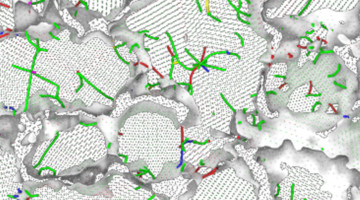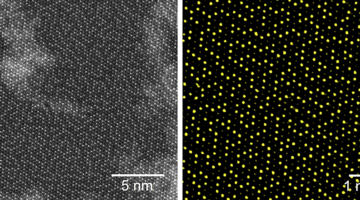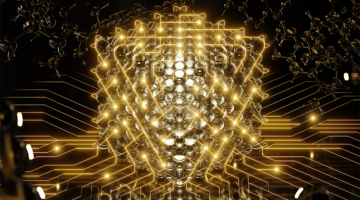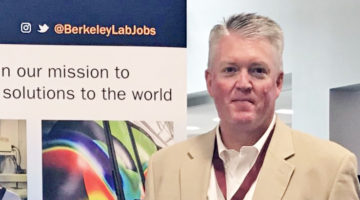Researchers used in situ high-pressure diffraction to resolve a debate about whether a metal’s strength increases or decreases when its grain size decreases below a critical point. The results indicate that ultrastrong metals for future applications can indeed be achieved through grain-size refinement and grain-boundary engineering. Read more »
2D Electronics Get an Atomic Tuneup
Researchers demonstrated a promising avenue for controlling atomic ordering in semiconductor alloys by engineering frustrated interactions in a 2D transition metal dichalcogenide (TMD). The work could lead to improved semiconductor performance for next-generation electronics such as optoelectronics, thermoelectrics, and sensors. Read more »
Roland Koch, Research Scientist
Roland Koch first became fascinated with synchrotron work at BESSY in Germany. He has been at the ALS ever since he finished his PhD and is happy to teach others everything from getting more meaningful data to flying a plane. Read more »
Rotavirus VP3 Is a Multifunctional Capping Machine
Rotavirus, a major cause of infantile gastroenteritis, is responsible for the deaths of about 200,000 children per year. Although vaccines are available, the virus still circulates, and a fuller understanding of the viral structures is needed. Here, scientists investigate the structure and function of the last unsolved rotavirus structural protein. Read more »
2020 Shirley Award to Honor Miquel Salmeron
By taking surface studies from ultrahigh vacuum to near-ambient pressure, Miquel Salmeron’s work at the ALS has had deep impact on a broad range of scientific questions, revealing the chemical, electronic, and mechanical properties of surfaces and interfaces on the nanometer (and often atomic) scale. Read more »
X-Rays Recount Origin of Oddball Meteorites
Reconstructions of 3D patterns of magnetic orientation imprinted in rare meteorites helped resolve questions about their origins. Known as type IIE iron meteorites, they appear to have originated from a parent body that had a composition featuring both fully melted and unmelted parts—other meteorite types display only one composition. Read more »
COSMIC Probes Evolution of Single-Atom Platinum Catalyst
Researchers synthesized a single-atom platinum catalyst that outperformed, by a factor of 15, conventional platinum-based catalysts, which are used for fuel cells and automotive emissions control. Operando x-ray spectromicroscopy at the ALS’s COSMIC beamline revealed how electronic interactions affect the material’s morphology. Read more »
Battery Breakthrough Gives Boost to Electric Flight and Long-Range Electric Cars
While lithium metal extends an EV’s driving range, it also shortens the battery’s useful life due to lithium dendrites that can cause short circuits. Researchers report a new class of soft, solid electrolytes—made from both polymers and ceramics—that suppress dendrites, before they can propagate and cause the battery to fail. Read more »
In Memoriam: Derrick Crofoot, ALS Senior Material Specialist
The ALS has lost a member of our family. Derrick Crofoot, a senior material specialist, died earlier this month. The Crofoots are a Berkeley Lab family—Derrick’s brother, Garret, also works at Berkeley Lab, and their father, Mike, worked at the Lab until his retirement. Derrick’s warmth and friendly personality played an important role in making the ALS feel like a family. We grieve together. Read more »
Will Hutcheson, Mechanical Engineering Group Leader
Will Hutcheson has been problem solving since childhood—a necessity growing up on a farm. Playing college football cemented his appreciation for cohesive teams, a mindset that has served him well at Berkeley Lab, the home of team science. Learn more about his vision for the ALS. Read more »
- « Previous Page
- 1
- …
- 20
- 21
- 22
- 23
- 24
- …
- 28
- Next Page »









